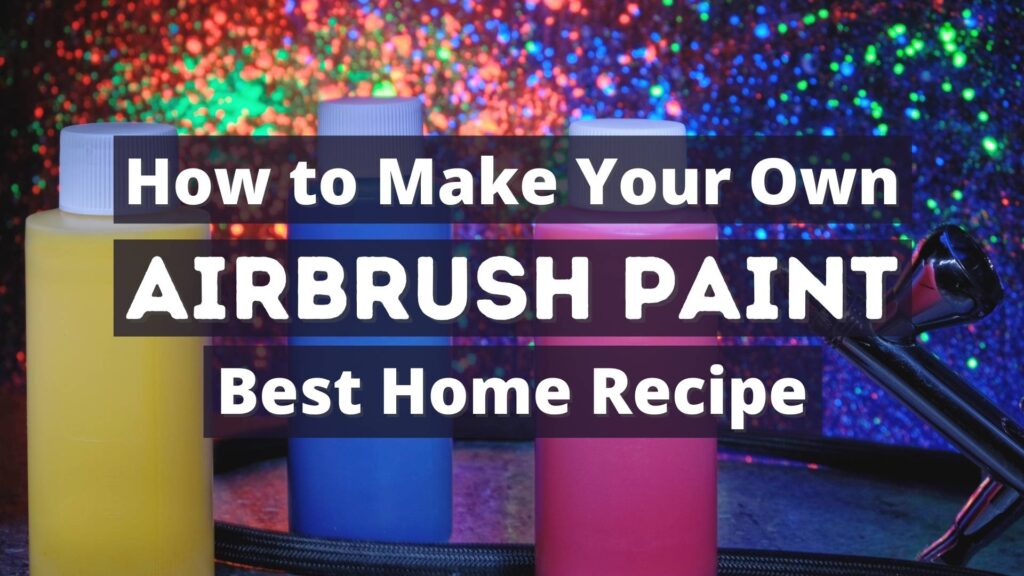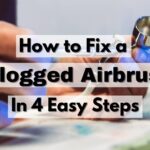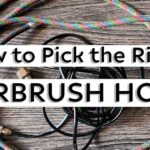If you’re sick of expensive store-bought airbrush paint, it might be time for you to make your own.
I’ve tried to spray many substances out of my airbrush and I can tell you that the right consistency will make or break your homemade airbrush paint – here’s my recommendation:
Make your own airbrush paint with a combination of acrylic craft paint and airbrush paint thinner/reducer. Mix your airbrush paint in 2 oz bullet bottles for easy pouring and storage.
This article dives into the fine art of jipping the expensive airbrush paint companies and making your own – ingredients, step-by-step instructions, and best practices for using normal paint in an airbrush.
If you try this method of making your own airbrush paint and you don’t like how it turns out, you can always go back to the store-bought brands. Here’s my recommendation for the best store-bought acrylic airbrush paint: Createx Colors.

What You Need to Make Your Own Airbrush Paint
Here are the 3 things you need to make your own airbrush paint:
- acrylic craft paint
- airbrush paint thinner/reducer
- bullet bottle
1. Acrylic craft paint can be bought at your local department store or art store. You can also pick some up from Amazon. Generally speaking, normal craft acrylics are much cheaper than airbrush-specific brands. It’s really up to you how much money you want to save and the colors you want to use.
2. Airbrush paint thinner (also called reducer) is a solvent specifically made for airbrush paint. this is what will make your normal acrylic paint the right consistency for spraying out of an airbrush.
3. Bullet bottles work great for mixing small quantities of paint and then dispensing them into the airbrush. They also work great for storing and organizing your airbrush colors once you mixed them. 2 oz bottles are a great size for measuring purposes.
The trick for making your own airbrush paint is to get the proportions right. An airbrush is a finely tuned device that needs paint of a certain consistency to work – too thick and the paint will clog the needle, too thin and it will drip out of the end.
Airbrush paint should be the consistency of skim milk. An optimal consistency can be achieved by reducing most water-based acrylic airbrush paints by 10%. Some thicker acrylic paints will need up to 25% reduction to be airbrush-ready.
Use trial and error to get your paint to the right consistency. Remember, you can always add more thinner but you can’t take it out.
How to Make Your Own Airbrush Thinner
If you really want to make airbrush paint completely from scratch, here’s how you can mix your own airbrush thinner:
- 3 parts distilled water
- 1 part isopropyl alcohol
- a few drops of glycerin
This mixture mimics the paint thinner nicely – the distilled water provides a nice base, isopropyl alcohol slightly lowers the viscosity, and glycerin optimizes how fast it will dry.
How to Make Your Own Airbrush Paint Step-by-Step
Once you have all your ingredients, you’re ready to put them together and make some airbrush paint.
Here’s how to make your own airbrush paint step-by-step:
STEP 1: Squirt about half a bottle of acrylic craft paint into a bullet bottle. This should come out to be 1 oz of paint.
STEP 2: Add 1 teaspoon of airbrush thinner to the mixture. This comes out to be 10% of 1 oz.
STEP 3: Shake the bullet bottle vigorously with the cap on for about 30 seconds to mix the ingredients together.
STEP 4: Check to see if the paint is the consistency of skim milk. You can often get a good idea by taking off the cap and looking inside. You can also dip a tongue depressor or a toothpick into the paint to see how thick it is.
STEP 5: If the paint is still too thick, add a few more drops of thinner at a time, shake the bottle, and check the consistency.
STEP 6: Try some paint in your airbrush! Start with a higher PSI and work your way lower to see how well it flows. If it’s still too thick to flow well out of the airbrush, keep adding drops of thinner until it’s just the right consistency.
Can You Use Normal Paint in an Airbrush?
Airbrush paint is slightly different from normal paint in that it is mixed for optimal flow in an airbrush. This means that airbrush paint is usually put together slightly different than normal paint:
- The paint pigments need to be fine enough to flow out of the nozzle at lower pressure settings.
- The resin needs to flow well out of the nozzle but also dry on the substrate. If the drying time is too long, the paint risks pooling and dripping before it dries.
- Thickness and drying time need to be maintained without sacrificing binding characteristics that hold the paint together.
Since normal paints don’t necessarily have these characteristics, there is a way to actually use them in your airbrush:
Normal paint can be used in an airbrush by thinning them or mixing them with an airbrush medium. Airbrush mediums are basically airbrush paint without the pigments. This makes them a great option for turning acrylic colors into sprayable airbrush paint.
Airbrush medium mixes with most acrylic craft paint at about a 1:1 ratio. The medium will slightly thin the acrylic paint, but more importantly, provide flow and drying characteristics that work nicely in an airbrush.
Airbrush paint is a simple concoction when you really break it down. Hopefully, this article has given you a good starting point to make your own airbrush paint.
When it comes down to it, the sky’s the limit for how you mix and use your airbrush paints. Check out this article about airbrush paint additives for more information on some of the products available to you for paint mixing.
This method has worked for me so I am confident it will work for you as well. However, I am also interested in hearing about other people’s methods.
Let me know in the comments how you make your airbrush paint!
Until next time, keep on painting!





